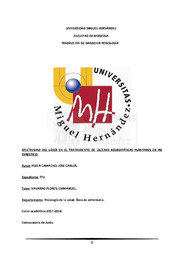Resumen :
INTRODUCCIÓN: El pie diabético es una alteración de base etiopatogénica neuropática inducida por la hiperglucemia mantenida en la que con o sin coexistencia de isquemia, y previo desencadenante traumático, produce lesión y/o ulceración del pie, lo que supone un elevado coste económico.
Es fundamental acelerar el proceso de reparación de los tejidos, siendo la terapia con láser de bajo nivel un recurso terapéutico muy eficiente.
OBJETIVOS: El objetivo principal de este trabajo es valorar la eficacia del láser en el tratamiento de úlceras neuropáticas de pie diabético. Además, dar a conocer otra alternativa a considerar para el tratamiento, con la finalidad de finalizarlo con la mayor brevedad.
MATERIAL Y MÉTODOS: Se llevó a cabo mediante una búsqueda en las bases de datos PubMed/Medline, Dialnet, Science Direct y Teseo, quedando un total de 236 revisiones, encontradas con las palabras clave; pie diabético, neuropatía diabética, úlcera neuropatica, tratamiento y Láser.
RESULTADOS: Tras realizar la búsqueda, 236 artículos fueron encontrados, de los cuáles tan solo 35 artículos fueron preseleccionados para la clasificación tras la revisión del abstract, mientras que 30 artículos quedaron excluidos tras ser examinados por no presentar relevancia. Una vez analizados los artículos preseleccionados, 5 artículos fueron los que quedaron, por mostrar relevancia en el contenido.
DISCUSIÓN: La revisión ha demostrado la eficacia de esta terapia. Pero, esta tiene puntos débiles, ya que, no es fácil establecer protocolos de tratamiento uniforme debido a la falta de estudios con mayor muestra para obtener resultados más fiables.
CONCLUSIÓN: La terapia con láser puede usarse como terapia coadyuvante en el tratamiento de úlceras neuropáticas plantares en pacientes diabéticos, ya que no es invasiva, tiene costos bajos y es una terapia rápida sin efectos adversos significativos.
Serán necesarios grandes estudios prospectivos controlados, aleatorizados y de doble ciego para confirmar la prometedora eficacia de esta forma de fototerapia
INTRODUCTION: Diabetic foot is an alteration of neuropathic etiopathogenic base induced by sustained hyperglycemia in which, with or without coexistence of ischemia and, traumatic trigger, it produces injury and / or ulceration of the foot, which supposes a high economic cost. It is essential to accelerate the process of tissue repair, using low level laser as a very efficient therapy.
OBJETIVES: The main objective of this work is to assess the effectiveness of the laser in the treatment of diabetic foot neuropathic ulcers. In addition, making known another alternative to be considered for the treatment, in order to complete it as soon as possible.
MATERIALS AND METHODS: It was carried out by means of a search in the PubMed / Medline, Dialnet, Science Direct and Teseo databases, with a total of 236 revisions, found with the keywords; diabetic foot, diabetic neuropathy, neuropathic ulcer, treatment and Laser.
RESULTS: After conducting the search, 236 articles were found, of which only 35 articles were pre-selected for classification after review of the abstract, however 30 articles were excluded after being examined for not presenting relevance. Once the pre-selected articles were analyzed, 5 articles were chosen, because they showed relevance in the content.
DISCUSSION: The review has shown the effectiveness of this therapy. But, this has weaknesses, due to it is not easy to establish uniform treatment protocols because of the lack of studies with more sample to obtain more reliable results. CONCLUSION: Laser therapy can be used as adjuvant therapy in the treatment of plantar neuropathic ulcers in diabetic patients, since it is non-invasive, it has low costs and is a fast therapy without significant adverse effects. Large, prospective, randomized, double-blind controlled trials will be necessary to confirm the promising efficacy of this way of phototherapy
|
 La licencia se describe como: Atribución-NonComercial-NoDerivada 4.0 Internacional.
La licencia se describe como: Atribución-NonComercial-NoDerivada 4.0 Internacional.
.png)
